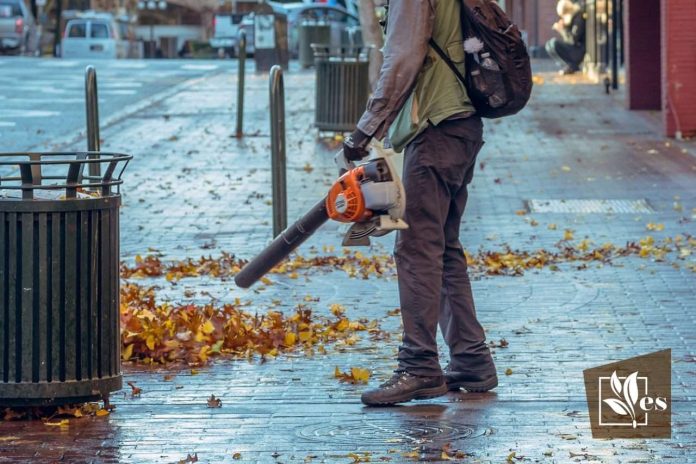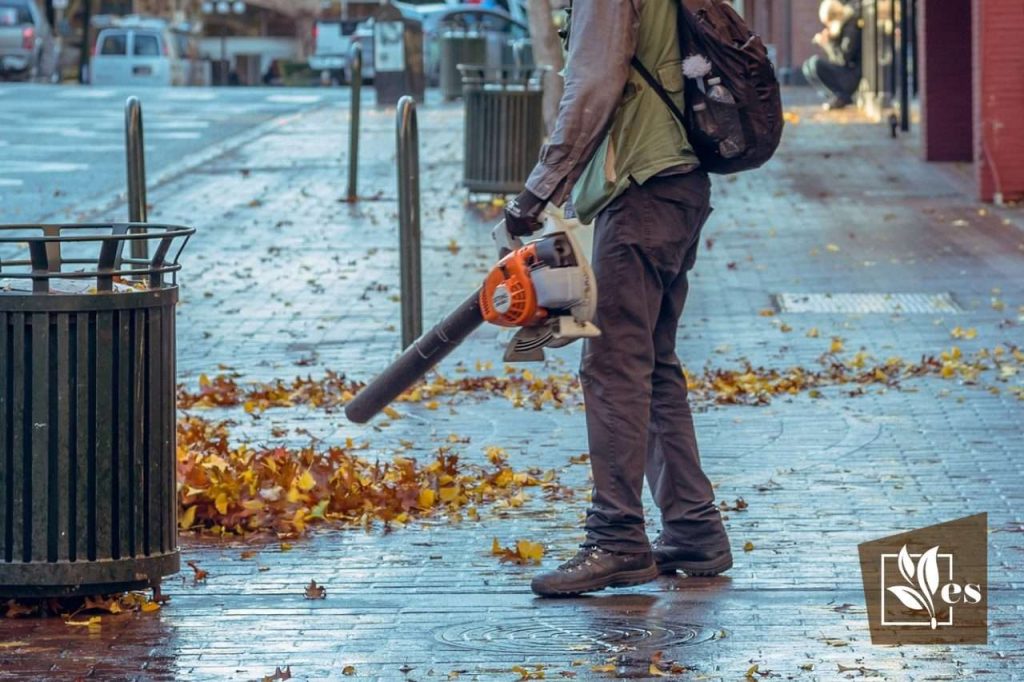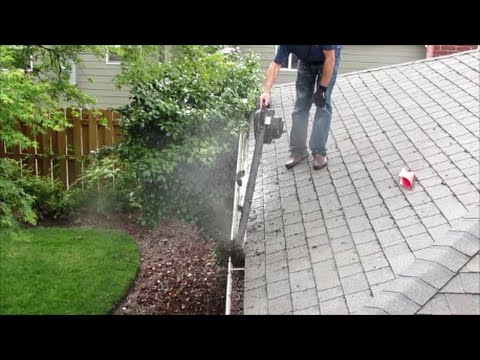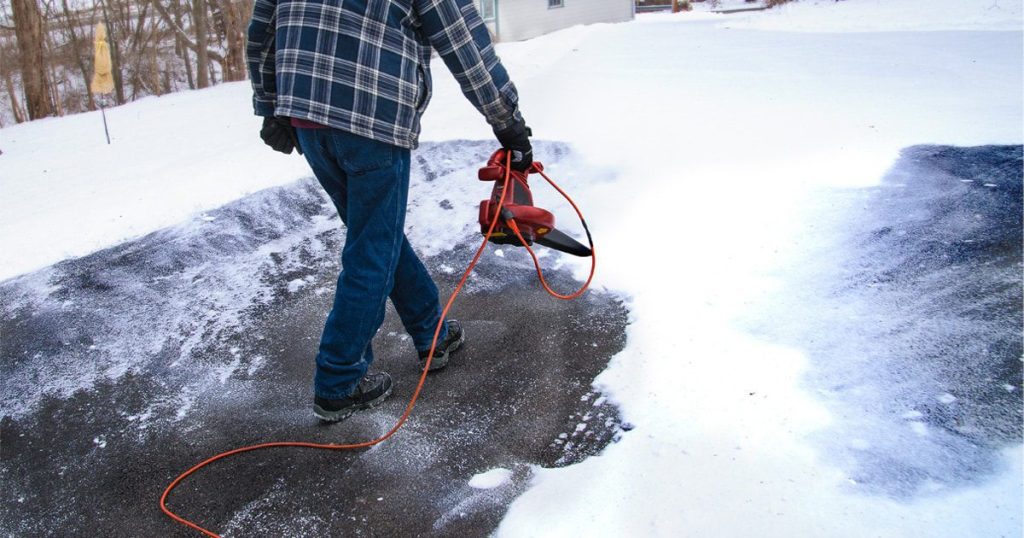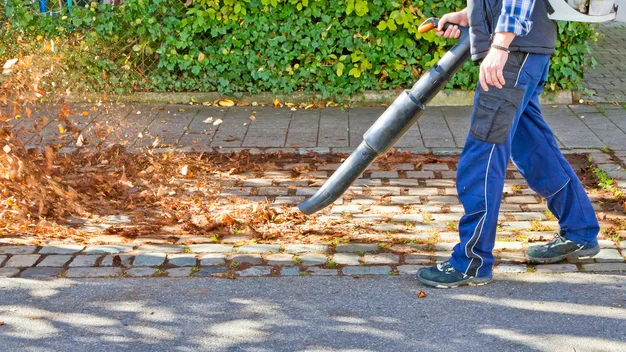Have you ever wondered if using a leaf blower is an effective way to clean your driveway and sidewalks?
In this article, we will explore the answer to this question and provide you with all the information you need.
Whether you’re tired of spending hours sweeping or just curious about alternative cleaning methods, discover if a leaf blower could answer your cleaning woes.
The Benefits of Using a Leaf Blower
Efficiency
Using a leaf blower can be highly efficient when cleaning your driveway and sidewalks. Instead of spending hours sweeping or raking, a leaf blower can quickly clear away debris and leaves in a fraction of the time.
The powerful airflow produced by a leaf blower can quickly blow away even the most stubborn dirt and leaves, leaving your surfaces clean and debris-free.
Versatility
One of the key benefits of using a leaf blower is its versatility. Leaf blowers come with different nozzle attachments that allow you to adjust the airflow according to your specific needs.
Whether you need a concentrated stream of air to clear out tight corners or a wide dispersion to cover a larger area, a leaf blower can quickly adapt to different cleaning tasks. Additionally, some leaf blowers come with vacuum and mulching capabilities, providing even more versatility for your outdoor cleaning needs.
Time-saving
With the fast and efficient cleaning power of a leaf blower, you can save a significant amount of time when cleaning your driveway and sidewalks.
Instead of manually sweeping or raking, which can be tedious and time-consuming, a leaf blower can complete the task in a fraction of the time. This time-saving aspect is particularly beneficial if you have a larger outdoor space or want to clean your driveway and sidewalks to maintain their cleanliness.
Easy to Use
Using a leaf blower to clean your driveway and sidewalks is incredibly easy. Most leaf blowers feature a simple design and intuitive controls that make them user-friendly, even for beginners.
They are lightweight and ergonomically designed, ensuring comfortable handling during use. Whether you have prior experience with power tools, you can quickly learn how to operate a leaf blower and achieve effective cleaning results with minimal effort.
Considerations Before Using a Leaf Blower
Noise Levels
Before using a leaf blower, it’s essential to consider the noise levels it produces. Leaf blowers can be loud, and if you live in a residential neighborhood, the noise may disturb your neighbors.
To minimize noise pollution, choose a leaf blower with a lower decibel rating or consider using it during daytime hours when noise restrictions may be more lenient. Additionally, wearing ear protection can help reduce the impact of the noise on your ears.
Environmental Impact
While leaf blowers offer convenience and efficiency, it’s essential to consider their environmental impact. Gas-powered leaf blowers emit pollutants into the air, contributing to air pollution.
Electric leaf blowers, on the other hand, produce zero emissions during use. If you are concerned about the environment, opt for an electric leaf blower, which is more eco-friendly. Additionally, always properly dispose of any debris you collect with the leaf blower to prevent environmental contamination.
Safety Measures
Using a leaf blower safely is crucial to prevent accidents or injuries. Before using a leaf blower, familiarize yourself with the manufacturer’s instructions and safety guidelines. This includes wearing protective gear such as safety glasses, gloves, and sturdy footwear to protect yourself from debris or flying objects.
It’s also important to be mindful of your surroundings, avoiding blowing debris towards people, animals, or fragile objects. Taking proper safety precautions will ensure a safe and incident-free cleaning experience.
Local Regulations
Before using a leaf blower, familiarize yourself with any local regulations or restrictions that may be in place. Some cities or neighborhoods have specific rules regarding using leaf blowers, such as noise restrictions or designated operating hours.
Adhering to these regulations can avoid potential fines or conflicts with neighbors. Check with your local authorities or homeowner’s association to ensure you are using your leaf blower in compliance with existing regulations.
Choosing the Right Leaf Blower
Electric Leaf Blowers
Electric leaf blowers are popular for homeowners due to their convenience and eco-friendliness. They are lightweight, easy to maneuver, and produce minimal noise. Electric leaf blowers are powered by electricity, either through a corded design or a rechargeable battery.
Corded electric leaf blowers provide consistent power as long as they are plugged into an electrical outlet. In contrast, cordless electric leaf blowers offer greater mobility but may have limited battery life. When choosing an electric leaf blower, consider your outdoor cleaning needs and power availability.
Cordless Leaf Blowers
Cordless leaf blowers offer the advantage of freedom and mobility. With no cords to limit your movement, you can easily maneuver around your driveway and sidewalks without the hassle of dragging a cord behind you.
Rechargeable batteries power cordless leaf blowers, so it’s essential to consider their runtime and charging time. If you have a large area to clean or prefer the convenience of a cordless tool, opt for a cordless leaf blower with a longer battery life and faster charging capabilities.
Gas-powered Leaf Blowers
Gas-powered leaf blowers are known for their power and versatility. They are typically more powerful than electric leaf blowers, making them suitable for larger outdoor spaces or heavy-duty cleaning tasks. Gas-powered leaf blowers are powered by gasoline, which means they don’t have any cord restrictions or battery limitations.
However, they emit exhaust fumes and are generally louder than electric leaf blowers. If you require robust cleaning power and are comfortable with the maintenance and noise of gas-powered tools, a gas-powered leaf blower may be the right choice.
Preparing Your Driveway and Sidewalks
Clearing Larger Debris
Before using a leaf blower, clearing any larger debris from your driveway and sidewalks is essential. Remove any branches, rocks, or other objects that may obstruct the airflow of the leaf blower or cause damage to the tool. Clearing larger debris beforehand will ensure a smooth and efficient cleaning process.
Removing Loose Dirt and Dust
Once you’ve cleared larger debris, use the leaf blower to remove loose dirt and dust from your driveway and sidewalks. Start from one end and work towards the other, using sweeping motions with the airflow to blow away the dirt and dust effectively. Pay attention to corners and hard-to-reach areas to ensure thorough cleaning.
Securing Loose Objects
Before using a leaf blower, secure any loose objects in the vicinity. This includes patio furniture, potted plants, or any other lightweight objects that the strong airflow of the leaf blower may easily blow away. Secure these objects or move them to a safe location to prevent damage or accidents during cleaning.
Identifying Potential Obstacles
While preparing your driveway and sidewalks, take note of any potential obstacles that may pose a challenge during the cleaning process.
This may include tree roots, uneven surfaces, or delicate landscaping features. By identifying these obstacles beforehand, you can adjust your cleaning technique to avoid damage or disruption to your outdoor surroundings.
Using a Leaf Blower Effectively
Maintaining the Right Distance
To use a leaf blower effectively, it’s essential to maintain the proper distance between the nozzle and the surface you are cleaning.
Holding the leaf blower too close may scatter debris rather than blowing it away, while holding it too far may result in ineffective cleaning. As a general rule, keep the nozzle of the leaf blower approximately 4-6 inches above the ground for optimal cleaning efficiency.
Using the Correct Nozzle Attachment
Leaf blowers often come with different nozzle attachments that serve different purposes. These attachments regulate the direction and dispersal of the airflow.
When cleaning your driveway and sidewalks, choose the appropriate nozzle attachment based on the area you are cleaning. For concentrated cleaning in tight corners or crevices, use a narrower nozzle. For larger areas, use a wider nozzle for broader coverage.
Working Against the Wind
When using a leaf blower, it’s generally more effective to work against the wind. By blowing in the opposite direction of the wind, you can prevent the debris from being blown back onto the areas you have already cleaned.
However, if the wind is too strong, it may hinder your cleaning efforts. In such cases, adjust your technique or choose a time to clean when the wind is less severe.
Avoiding Damage to Landscaping
While using a leaf blower, you must be mindful of your landscaping features and avoid causing any damage. Directing the airflow towards delicate plants, flowers, or shrubs can harm them.
If you have fragile landscaping close to sidewalks, consider using a lower setting on the leaf blower or a broom or cleaning to minimize the risk of damage.
Safety Measures While Using a Leaf Blower
Wearing Protective Gear
To ensure your safety while using a leaf blower, it’s essential to wear the necessary protective gear. This includes safety glasses to protect your eyes from flying debris, gloves to shield your hands from potential injuries or blisters, and sturdy footwear to provide stability and protect your feet. Wearing protective gear will minimize the risk of accidents or injuries during cleaning.
Avoiding Loose Clothing and Jewelry
When operating a leaf blower, avoiding wearing loose clothing or jewelry that may get caught in the tool’s moving parts is crucial. Loose clothing or dangling jewelry can present a severe safety hazard and increase the risk of accidents or injuries. Wear fitted clothing and remove any jewelry before using a leaf blower to ensure safe operation.
Being Mindful of Surroundings
While using a leaf blower, always be mindful of your surroundings to prevent accidents or damage. Avoid blowing debris towards people, animals, or delicate objects.
Stay aware of your surroundings and be considerate of others who may be nearby. By practicing mindfulness, you can ensure a safe and respectful cleaning experience.
Preventing Electrical Hazards (for electric blowers)
If using an electric leaf blower, take precautions to prevent electrical hazards. Ensure the power cord is not damaged or frayed before plugging it into the electrical outlet.
Avoid using the leaf blower in wet or rainy conditions to minimize the risk of electric shock. Always follow the manufacturer’s instructions and guidelines to prevent electrical accidents.
Checking Fuel Levels (for gas-powered blowers)
If you use a gas-powered leaf blower, regularly check the fuel levels before each use. Running out of fuel during the cleaning process can be inconvenient and interruptive.
Ensure you have enough fuel to complete your cleaning job, and if necessary, have extra fuel on hand. Regularly maintain the fuel tank and follow the manufacturer’s fuel storage and usage recommendations to prevent any fuel-related accidents.
Dealing with Environmental Concerns
Minimizing Noise Pollution
While using a leaf blower, it’s essential to consider noise pollution. The loud noise from leaf blowers can disrupt you, your neighbors, and the surrounding environment.
Choose a leaf blower with a lower decibel rating to minimize noise pollution. Additionally, try to use the leaf blower during daytime hours when noise restrictions may be more lenient. Being mindful of noise levels can contribute to a quieter and more peaceful neighborhood.
Reducing Dust Dispersal
When using a leaf blower, it’s common for a certain amount of dust to be dispersed into the air. To reduce dust dispersal and keep the environment cleaner, consider spraying water over the areas you are cleaning before using the leaf blower.
This can help weigh down the dust particles and prevent them from becoming airborne. Using the leaf blower at a lower setting can also minimize the dust being blown around.
Considering Air Pollution
Gas-powered leaf blowers emit pollutants into the air, contributing to air pollution. If you are concerned about air quality and environmental impact, consider using an electric leaf blower instead.
Electric leaf blowers produce zero emissions during use, making them a more eco-friendly choice. Choosing an electric leaf blower can reduce your carbon footprint and contribute to a cleaner and healthier environment.
Disposing of Debris Properly
When using a leaf blower to clean your driveway and sidewalks, it’s essential to dispose of the collected debris properly.
Instead of blowing the debris into nearby green spaces or storm drains, gather it into a bag or container and dispose of it according to local waste management guidelines. Proper disposal ensures that the debris does not cause environmental contamination and helps maintain the cleanliness of the surrounding environment.
Maintaining Your Leaf Blower
Cleaning the Blower Regularly
Regular cleaning is vital to ensure your leaf blower’s optimal performance and longevity. After each use, remove any debris or clogs from the inlet and outlet openings. Check the air vents and make sure they are clear of any obstructions.
Use a soft brush or cloth to clean the exterior of the leaf blower, removing any dirt or residue. Keeping your leaf blower clean can prevent debris buildup and maintain its efficiency.
Checking Air Filters
Air filters play a crucial role in the operation of a leaf blower. Over time, the air filters can become dirty or clogged, affecting the airflow and performance of the tool. Regularly check the air filters and clean or replace them as needed.
Following the manufacturer’s instructions, remove and clean the air filters using compressed air or water. If the filters are damaged or excessively dirty, replace them with new ones to ensure optimal performance.
Inspecting and Replacing Parts
Inspecting your leaf blower’s parts regularly can help identify any wear and tear or damage that may affect its functionality. Check the nozzle attachments, hoses, and other components for any signs of damage or deterioration.
If parts are broken or not functioning correctly, replace them promptly to avoid further damage to the leaf blower or compromise its performance. Regular maintenance and timely parts replacement will ensure your leaf blower operates at its best.
Storing the Blower Safely
Proper storage is essential to prolong the lifespan of your leaf blower. After each use, clean the blower and remove any dirt or debris. Disconnect any power sources, such as batteries or power cords, and store them separately.
Find a dry and secure location to store your leaf blower away from extreme temperatures or excessive moisture. Use a dedicated storage container or bag to protect the leaf blower from dust and potential damage.
Seeking Alternatives to Leaf Blowers
Using a Broom or Rake
While leaf blowers offer convenience and efficiency, a broom or rake can be a viable alternative for cleaning your driveway and sidewalks. Brooms and rakes are cost-effective, require no power source, and provide a more hands-on cleaning approach.
They are handy for smaller areas or those who prefer manual tools. Using a broom or rake can also be more eco-friendly, eliminating the noise and air pollution associated with leaf blowers.
Employing Manual Sweeping Tools
Manual sweeping tools, such as a push broom or a manual sweeper, can provide an effective and low-tech method for cleaning your driveway and sidewalks.
These tools are designed to collect debris and dirt into a collection bin or pile, making it easy to dispose of the collected waste. Manual sweeping tools can be used in conjunction with a broom or rake, providing an alternative that combines automation’s benefits with manual cleaning control.
Hiring Professional Cleaning Services
If you prefer to leave the cleaning of your driveway and sidewalks to the professionals, hiring a professional cleaning service is an excellent option.
Professional cleaners have the knowledge, experience, and appropriate equipment to quickly and efficiently clean outdoor surfaces.
They can use a combination of tools, such as power washers or manual sweepers, to ensure a thorough and effective clean. By hiring professionals, you can save time and effort while achieving high-quality results.
Conclusion
In conclusion, using a leaf blower to clean your driveway and sidewalks offers numerous benefits. It is efficient, versatile, time-saving, and easy to use. However, it is essential to consider noise levels, environmental impact, safety measures, and local regulations before using a leaf blower.
Choosing the suitable leaf blower, preparing the surfaces properly, and using the leaf blower effectively is crucial for optimal cleaning results. Practicing safety measures and being mindful of environmental concerns further enhance the leaf blower’s usage.
Regular maintenance and considering alternatives are essential for the long-term maintenance of your leaf blower. Whether you decide to use a leaf blower or explore other cleaning methods, keeping your driveway and sidewalks clean contributes to your outdoor space’s overall aesthetics and safety.

